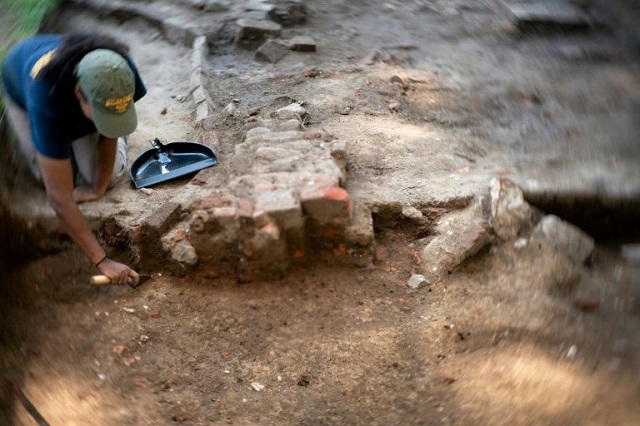
After a terrifying crossing of the Atlantic, Angela was one of the first African slaves known to reach the first permanent English settlement in North America, which would later be part of the United States.
"I see a lot of connections with my own family's background, and what began here, in 1619," said Reid, a 32-year-old African-American Virginia native.
She calls the first slaves to reach the state "our foremothers and our forefathers -- of not only African-American culture, but American culture in general."
Reid herself says her family tree includes a white indentured servant and a black slave.
As she works, bricks begin to appear -- the remnants of more recent buildings erected on the site of the Jamestown estate where Angela lived.
Black History Month: Tales of slavery and struggle
The rolling green landscape, which gently slopes towards the James River, is likely not all that different to the one that the African slaves saw upon their arrival in August 1619.
At the time, Portuguese and Spanish slave traders had already been selling Africans as labourers in the Americas -- Brazil, for instance -- for nearly a century.
Originally from the kingdom of Ndongo, in what is now Angola, Angela was loaded onto a Portuguese ship in Luanda, which then headed to Veracruz, in the Spanish colony of modern-day Mexico.
Nearly a third of the 350 slaves died before the Atlantic crossing was complete because of the dire conditions on board the vessel.
And before reaching Veracruz, two privateer ships attacked the Portuguese vessel and snatched about 60 Africans, according to James Horn, president of the Jamestown Rediscovery Foundation in charge of the dig.
The first of the two, the White Lion, arrived in Virginia in "the latter end of August" 1619, wrote John Rolfe, a wealthy English settler who was the husband of Pocahontas, whose father was a powerful native American tribal leader.
Arriving at Point Comfort -- today Fort Monroe, near Jamestown -- the privateers exchanged "20 and odd" Africans for needed supplies.
The second ship, the Treasurer, arrived soon thereafter, dropping off a small group.
The only woman whose name was preserved for history was Angela, "the first documented African woman in Virginia," said Bly Straube, the curator at the Jamestown Settlement, a living history museum.
"To me, the story is sort of like Eve," Straube said.
"She and her fellow Africans who arrived in 1619 are the founding generation of what would become our African-American community today. That's the beginning."
Their arrival marks the beginning of a dark period of US history: 250 years of slavery followed by a long period of racial segregation, the repercussions of which are still felt in American society.
The enslaved Africans arrived shortly after settlers founded the first local legislature on July 30, 1619 -- in what Horn calls a "paradox" of history.
Just weeks after "the first expression of our democratic experiment" came the arrival of people "stripped of their rights, and even their identity," the historian said.
"That's a fundamental part of our story as Americans."
For Terry Brown, the first black superintendent of the Fort Monroe National Monument, the history of slavery in the United States is "the greatest survival story written in American history."
Brown and his team are preparing a series of events on August 23-25 to celebrate the "contributions" of Africans to US society.
"The more we gather around, the more we talk, the easier it is to break with the insidiousness of racism," said Brown, who discovered through a DNA test that his ancestors came from Cameroon.
He says "it's really emotional" to think about the first Africans arriving in Virginia, including Angela.
"That's 400 years ago. Who would have ever imagined that I would be here standing on their shoulders?"
About 30 Africans in all were counted in Virginia in early 1620.
Angela's name appears in the colony's census documents in 1624 and 1625 -- she is listed as "Angelo." Some historians disagree on her actual name, which was probably given by the Portuguese.
But all agree that she was a slave to the wealthy Pierce family. She likely worked in the house and the orchards, according to Straube.
She also likely lived alongside white servants, according to Straube and Horn.
Pakistan home to world's third-largest 'slave' population
It was only 40 years after Angela's arrival, in around 1660, that several English colonies in North America decreed that slave status would be transmitted via the mother.
Interracial marriage was banned, a prohibition that continued in some US states well into the 20th century.
After 1625, Angela disappears from the records, but her name is now more than ever in the spotlight in Jamestown.
Research on the first Africans gives "the fuller story of the American past, which we're still struggling with," said Reid.
"I am very optimistic that we are having a sea change here. And it's really, really incredible to be a part of it."
1736927836-0/hugh-sutton-(1)1736927836-0-405x300.webp)
1736926952-0/Untitled-design-(91)1736926952-0-165x106.webp)

1736926441-0/BeFunky-collage-(49)1736926441-0-165x106.webp)


1736924527-0/sidra--(3)1736924527-0-270x192.webp)

1736922471-0/sidra--(2)1736922471-0-270x192.webp)








COMMENTS
Comments are moderated and generally will be posted if they are on-topic and not abusive.
For more information, please see our Comments FAQ